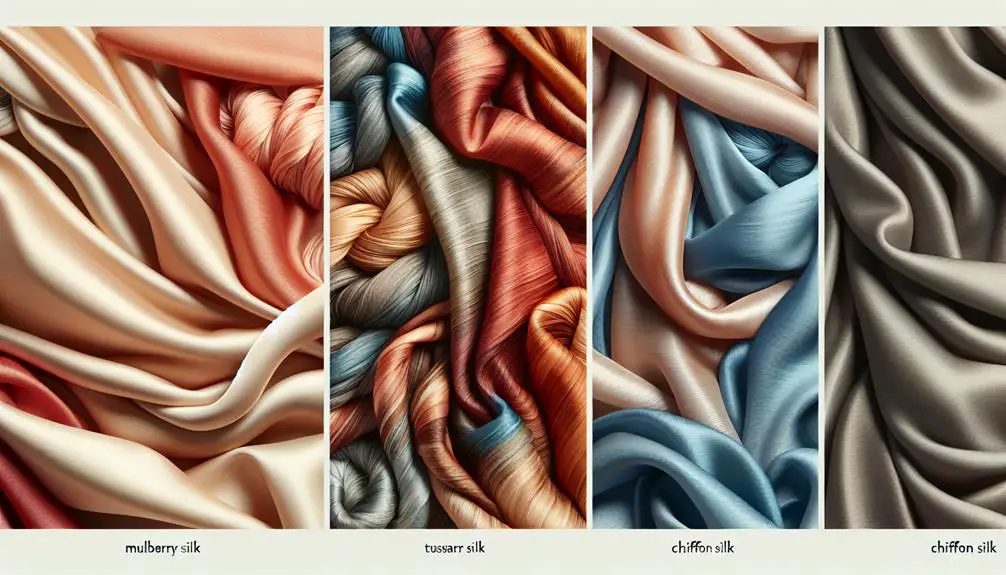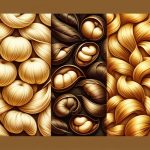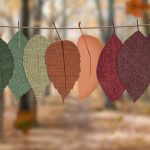I found out there are several types of silk, like Mulberry, Wild, Spun, and Art Silk. Each has unique qualities for different uses. If you're curious for more details, keep exploring the fascinating world of silk!
Table of Contents
Key Takeaways
- Natural silk types include mulberry, tasar, eri, muga, and spider silk.
- Mulberry silk is renowned for its fine texture and durability.
- Wild silk varieties like muga and tasar offer unique properties for ethnic wear.
- Spun silk, coarser than reeled silk, is used in blends for its affordability.
- Art silk, a synthetic fiber, imitates real silk using materials like rayon and polyester.
Natural Silk
Natural silk encompasses various types, including mulberry silk, tasar silk, eri silk, muga silk, and spider silk, each offering distinct characteristics and uses in the textile industry.
Mulberry silk, constituting the majority of silk production globally, is renowned for its fine texture and durability.
Tasar silk, produced by non-mulberry caterpillars, presents a unique feel and quality, differentiating it from mulberry silk.
Eri silk, derived from Samia and Philosamia ricini silkworms without causing harm, serves as a robust material suitable for clothing and soft furnishings.
Muga silk, prized for its lustrous golden yellow shade, originates from semi-domesticated silkworms feeding on soalu plants, making it a preferred choice for traditional attire in Assam.
While spider silk boasts a soft and delicate nature, its application in the textile industry remains limited due to the high production costs associated with non-insect spider farming.
Each type of natural silk brings its own unique attributes and contributions to the diverse landscape of textiles.
Mulberry Silk
I'll start by explaining the production process of Mulberry silk, detailing how Bombyx mori silkworms feed on mulberry bushes to create this luxurious fabric.
Then, I'll highlight the benefits of Mulberry silk, emphasizing its delicate, durable, and smooth qualities that make it a preferred choice for high-end garments.
Production Process of Mulberry Silk
Harvesting mulberry leaves to feed Bombyx mori silkworms marks the initial step in the production process of Mulberry Silk. These silkworms are carefully reared indoors in controlled environments to guarantee the quality of silk production.
Mulberry silk, accounting for approximately 90% of the world's silk supply, is highly favored for its delicate and smooth properties, especially in regions like China, Japan, and Korea. The process involves meticulous steps like harvesting, spinning, and weaving to yield luxurious and high-quality fabric.
This method guarantees that the silk maintains its premium quality and is renowned for its fine texture and durability. The intricate production process underscores the dedication and craftsmanship involved in creating Mulberry Silk.
Benefits of Mulberry Silk
Stepping into the realm of Mulberry Silk's advantages exposes a world of opulence and coziness that enchants both designers and consumers alike. Mulberry silk, derived from the Bombyx mori silkworms, is renowned for its high quality, luxurious feel, and versatility. Let's explore the benefits of this exquisite silk through the table below:
| Benefits of Mulberry Silk |
|---|
| 1. High Quality |
| 2. Luxurious Feel |
| 3. Versatile |
Mulberry silk's reputation for being delicate, durable, and smooth makes it a preferred choice for creating elegant and comfortable silk products. Its ability to take dye well and come in various colors further enhances its appeal, allowing for a wide range of design possibilities for both creators and consumers seeking sophistication and comfort.
Wild Silk
Wild silk, like Muga and Tasar, showcases distinct characteristics such as rich hues and textured finishes, setting them apart from conventional silks like Mulberry.
These unique qualities make wild silk a preferred choice for creating traditional ethnic wear that highlights regional artistry and cultural heritage.
The uses of wild silk extend beyond clothing, contributing to a natural and rustic aesthetic in high-end fashion and textile designs.
Different Wild Silk Varieties
Originating from various regions around the world, wild silk encompasses a diverse range of varieties, each with unique characteristics and applications in the domain of textile production. Here are some notable wild silk varieties:
| Wild Silk | Origin | Characteristics |
|---|---|---|
| Anaphe silk | Africa | Elastic, strong, used for velvet and plush fabrics |
| Coan silk | Mediterranean | Ancient Rome crimson-dyed clothes, blends well |
| Eri silk | Assam, India | Creamy white, durable, ideal for clothing |
Each of these wild silks offers distinct properties that cater to different textile needs, from elasticity and strength to unique color variations.
Characteristics of Wild Silk
Exploring the unique characteristics of wild silk varieties reveals a diverse range of textures and colors that cater to various textile needs.
Muga silk, originating from Assam, India, is renowned for its natural golden yellow hue, commonly used in sarees and traditional attire.
On the other hand, Tasar silk, with its deep golden color, is perfect for lightweight garments like blouses and dresses, providing warmth and a rustic appearance.
Wild silk fabrics, such as Muga and Tasar, are sought after for their unique textures and natural colors, making them suitable for a variety of clothing items.
These materials are often utilized in traditional and cultural garments due to their distinct properties and regional significance, offering a strong and durable alternative to mulberry silk with a different aesthetic and feel in textiles.
Uses of Wild Silk
With their unique textures and vibrant colors, wild silk fabrics like Muga and Tasar offer a versatile and durable option for various clothing and home furnishing needs. Muga silk, originating from Assam, India, with its natural golden yellow hue, is commonly used in sarees and traditional attire. On the other hand, Tasar silk, known for its deep golden color, is ideal for lightweight garments such as blouses and dresses, providing warmth and a homespun aesthetic. These wild silks are popular for their distinct qualities and are traditionally used in clothing and home spinning. The table below summarizes the key uses of Muga and Tasar silk:
| Wild Silk Type | Origin | Common Uses |
|---|---|---|
| Muga Silk | Assam | Sarees, Traditional Attire |
| Tasar Silk | India | Blouses, Dresses |
Spun Silk
Spun silk, derived from broken and leftover cocoons, is known for its coarser texture and lower sheen compared to reeled silk. Unlike the smooth and shiny finish of reeled silk, spun silk offers a more textured appearance, making it less lustrous. This type of silk is commonly utilized in creating fabrics such as silk blends, where its affordability and unique texture are valued.
The process of producing spun silk involves using damaged cocoons that are unsuitable for reeling due to imperfections incurred during the initial silk extraction. Despite its rougher feel and reduced sheen, spun silk still retains the inherent qualities of silk, providing a more budget-friendly option for silk-based products. While it may not have the luxurious appeal of reeled silk, spun silk serves a practical purpose in the textile industry, offering a cost-effective alternative for those seeking silk qualities in fabrics without the higher price tag.
Art Silk
Having discussed Spun Silk and its unique characteristics, let's now shift our focus to Art Silk, a synthetic fiber engineered to replicate the luxurious qualities of authentic silk.
Art silk, also known as artificial silk, is created using chemical processes to mimic the look and feel of real silk. This synthetic fiber is commonly crafted from materials such as rayon, polyester, and viscose.
Here are some key points about art silk:
- Art silk is designed to imitate the luxurious qualities of real silk.
- It's produced through chemical processes to achieve a silk-like appearance and texture.
- Common materials used to make art silk include rayon, polyester, and viscose.
- Regulations are in place to guarantee that artificial silk isn't mislabeled or sold as genuine silk.
The use of art silk offers a more cost-effective alternative to natural silk fabrics, making it a popular choice in the textile industry for those seeking the elegance of silk at a more affordable price point.
Spider Silk
Spider silk, known for its remarkable softness and fine texture distinct from traditional silkworm silk, presents unique challenges and opportunities in various industries. While spider silk is highly sought after for its exceptional properties, its limited availability and high cost hinder widespread use in the textile industry. The difficulty in mass-producing spider silk is primarily due to the small amount of yarn that can be obtained from spiders, making large-scale production a complex and costly process.
Despite these challenges, spider silk finds valuable applications in specialized fields such as manufacturing bulletproof vests and wear-resistant clothing. The unique characteristics of spider silk, including its strength and flexibility, make it ideal for creating protective gear that demands high performance standards. Typically sourced from species like Nephila found in regions like Madagascar, spider silk continues to be a material of interest for researchers and industries looking to harness its exceptional qualities. As technology advances and methods for producing spider silk improve, the potential for broader utilization of this extraordinary material may increase in the future.
Sea Silk
Sea silk stands out for its rarity and value, originating from a specific mollusc with a unique harvesting process.
It holds historical significance due to its exclusivity and delicate nature in the textile industry.
The naturally chestnut brown color of sea silk sets it apart from other types of silk, making it a sought-after commodity.
Rare and Valuable
Rare and valuable, the exquisite sea silk is a highly coveted material originating from a specific mollusc in the Mediterranean. This luxurious silk stands out due to its exceptional qualities:
- Extremely fine threads make sea silk a rare find.
- Natural chestnut brown color sets it apart from other silks.
- High demand is driven by its unique production process and limited availability.
- Delicate and expensive, sea silk is often auctioned at premium prices.
Sea silk's scarcity and unmatched quality contribute to its status as a luxury fabric, making it a prized possession for those seeking exclusivity and refinement.
Harvesting Process
With the delicate harvesting process of sea silk, artisans carefully gather the threads from mussels found along the shores of the Adriatic. These mussels, specifically the Pen Shell molluscs, provide the fibers used to create the rare and exquisite sea silk, also known as fish silk.
The exclusive production of sea silk is centered in Taranto, Italy, a tradition that dates back to the 8th century BCE. The unique natural chestnut brown color of sea silk adds to its allure, making it a luxurious and highly sought-after material.
Due to the intricate and labor-intensive process involved in harvesting and producing sea silk, it remains a symbol of luxury and exclusivity, with its origins deeply rooted in the history of the Adriatic shores.
Historical Significance
The historical significance of sea silk in the textile industry spans centuries, marking a legacy of luxury and exclusivity. Sea silk, also known as byssus or cloth of gold, is an exceptionally rare and fine silk harvested from the giant pen shell mollusc. This unique textile is naturally chestnut brown in color and is highly prized for its rarity and quality.
The production of sea silk is a meticulous and time-consuming process, contributing to its reputation as one of the most expensive textiles globally. The Italian city of Taranto, situated in the Mediterranean region, has a rich history of sea silk production dating back to ancient times, showcasing its enduring allure and value in luxury fabrics.
Tussar Silk
Derived from wild silkworms, Tussar silk is a textured variety valued for its unique appearance and texture. Unlike mulberry silk, Tussar silk is known for its less luxurious feel, making it a popular choice for those seeking a more rustic and natural look in their clothing and home furnishings.
One distinguishing feature of Tussar silk is its natural gold color, which adds a touch of elegance to the fabric. Traditionally used for making sarees, Tussar silk presents a challenge when it comes to dyeing due to its inherent hue. While not as durable as mulberry silk, Tussar silk's appeal lies in its distinct characteristics that cater to individuals looking for a different silk experience.
Its origins from wild silkworms contribute to its allure, offering a connection to nature and tradition that many find enthralling.
Eri Silk
Shifting from Tussar silk, Eri silk distinguishes itself with its exceptional thermal properties and wool-like texture, setting it apart as a unique silk variety. Eri silk is produced from Samia and Philosamia ricini silkworms, a process that guarantees the worms remain unharmed. This silk is spun on castor oil plants, resulting in a durable material suitable for clothing and soft furnishing applications. Due to the delicate care required during production, Eri silk may contain microorganisms, adding to its distinctive character. Commonly utilized for creating silk-blend items like curtains, Eri silk offers a blend of elegance and functionality in various textile products.
- Eri silk is known for its exceptional thermal properties.
- Samia and Philosamia ricini silkworms are used in the production of Eri silk.
- The silk is spun on castor oil plants, contributing to its durability.
- Eri silk is often used in the production of silk-blend items like curtains.
Muga Silk
Originating from Assam, India, Muga silk showcases a distinct natural golden yellow tint. This luxurious silk is a staple in traditional Assamese attire, often seen in garments like sarees and lehengas.
The unique golden hue of Muga silk comes from the semi-domesticated silkworms that feed exclusively on the aromatic soalu plants. The production of Muga silk is a meticulous process that results in a material highly valued for its quality and scarcity.
Due to its limited supply and high demand, Muga silk is a prized choice for crafting special garments like chaddars. Beyond its aesthetic appeal, Muga silk is renowned for its eco-friendly production methods and durable properties.
Its sustainable production makes it an attractive option for those seeking both luxury and environmental consciousness in their clothing choices.
Mussel Silk
With a history dating back to the 8th century BCE, mussel silk, also known as 'sea silk,' is a rare and luxurious fabric derived from mussels found along the Adriatic shores and spun into fish silk exclusively in Taranto, Italy. Mussel silk holds ancient roots and continues to be produced in a traditional manner in Taranto, Italy. Here are some key points about mussel silk:
- Mussel silk is obtained from mussels found along the Adriatic shores.
- The fabric is also known as 'sea silk' due to its origin from the sea.
- Taranto, Italy, is the exclusive location where mussel silk is combed and spun into fish silk.
- The production of mussel silk is a costly process, contributing to its high value and exclusivity.
Mussel silk stands out as a sought-after material due to its limited production, historical significance, and exceptional quality, making it a fabric that embodies luxury and heritage.
Anaphe Silk
Anaphe silk, produced in southern and central African countries, is renowned for its exceptional elasticity and strength compared to mulberry silk. This unique silk variety is highly prized for its ability to stretch without losing shape, making it ideal for garments that require durability and flexibility. Anaphe silk is often used in the production of luxurious fabrics like velvet, known for its softness and sheen.
The process of obtaining Anaphe silk involves harvesting cocoons enclosed in communes by silk-producing Anaphe larvae. This ancient method results in a durable silk that has a lustrous finish, adding to its desirability in the textile industry. Despite its strength, Anaphe silk remains soft to the touch, providing a comfortable and luxurious wearing experience.
Frequently Asked Questions
What Are Four Types of Silk?
There are four main types of silk: Mulberry, Eri, Tasar, and Muga. Each type has distinct qualities and applications. Mulberry is common, Eri is known for its thermal properties, Tasar is strong, and Muga is golden and traditional.
What Type of Silk Is the Best?
In my opinion, mulberry silk stands out as the best type due to its delicate appearance, natural sheen, and versatility. It's renowned for its exceptional smoothness, durability, and ability to take dye well.
What Is the Most Expensive Type of Silk?
The most expensive type of silk is sea silk, known as byssus, sourced from mussels on the Adriatic shores. Its rarity and exclusivity, limited production in Taranto, Italy, and ancient craftsmanship make it highly coveted.
What Are 10 Fabrics Made From Silk?
There are 10 fabrics made from silk. Some examples include Charmeuse, Chiffon, Crêpe-de-chine, and Dupion silk. Each fabric offers unique qualities ideal for various clothing items. Silk's versatility and luxurious feel make it a popular choice for many designers.
- How Does Ring Spun Cotton Affect Garment Fit and Shape Retention? - August 13, 2024
- What Are the Challenges in Producing Ring Spun Cotton? - August 13, 2024
- Is Ring Spun Cotton Suitable for Plus-Size Clothing? - August 13, 2024






